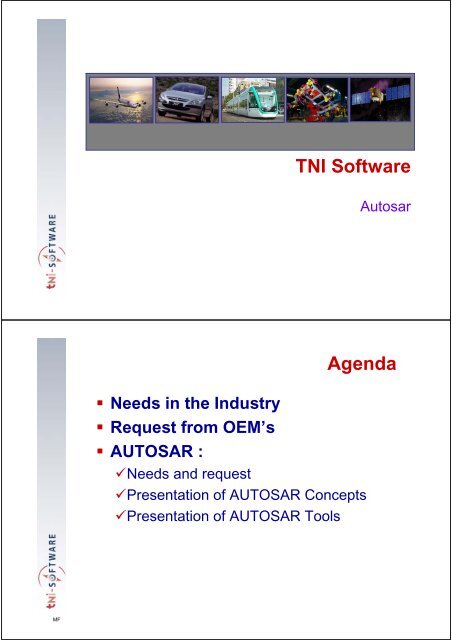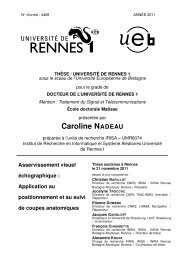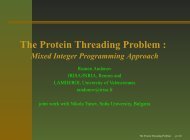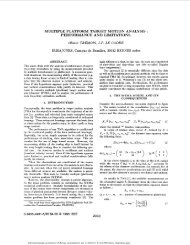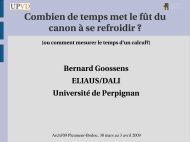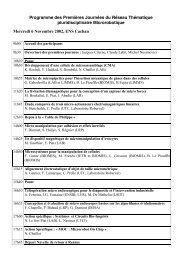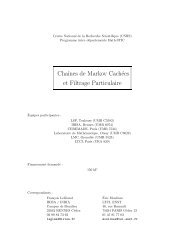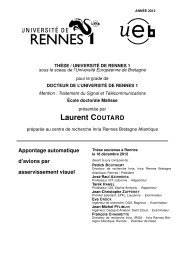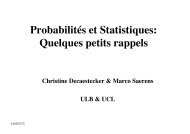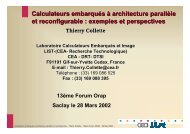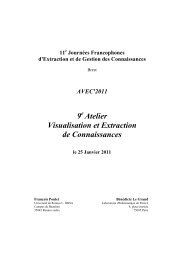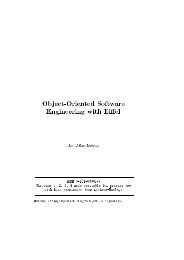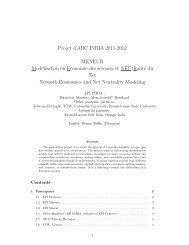TNI Software Agenda - Irisa
TNI Software Agenda - Irisa
TNI Software Agenda - Irisa
You also want an ePaper? Increase the reach of your titles
YUMPU automatically turns print PDFs into web optimized ePapers that Google loves.
MF<br />
standards<br />
� Needs in the Industry<br />
� Request from OEM’s<br />
� AUTOSAR :<br />
<strong>TNI</strong> <strong>Software</strong><br />
Autosar<br />
<strong>Agenda</strong><br />
�Needs and request<br />
�Presentation of AUTOSAR Concepts<br />
�Presentation of AUTOSAR Tools
Demanded Safety<br />
& Quality<br />
Million<br />
1000<br />
Unitary<br />
100<br />
Optimization / Volume<br />
standards<br />
AUTOSAR Concepts<br />
Why Autosar<br />
In Vehicle EE trends<br />
100% proven<br />
Traceable<br />
CMMI Levels<br />
Tested<br />
Improvements<br />
Digital control<br />
Indispensable<br />
Critical<br />
Complexity
Automotive OEM request<br />
Reduce Number of ECU for standard Functions<br />
� Engine Control<br />
� Breaking Control<br />
� Body Computer<br />
� Automatic Transmission<br />
� Gear selector<br />
� Steering Column<br />
� Steering Wheel<br />
� Steering angle sensor<br />
� Electric power steering<br />
� Parking Sensor<br />
� Dashboard<br />
� Adaptive Cruise Control<br />
� Tyre Pressure control<br />
� Air Bag unit Control<br />
� Driver Door<br />
� Passenger Door<br />
� Passive Entry<br />
� Driver seat ECU Trunk<br />
� Passenger seat<br />
� Left Headlight unit Control<br />
� Right Headlight control<br />
� Air Conditioning<br />
� Alarm Sensor/roof control<br />
� Rain/sun sensor<br />
� External light control<br />
� Alarm unit control<br />
� Infotainment<br />
Leave room for innovation<br />
NEW functions are first implemented as new ECU’s<br />
Driving Mechanics<br />
� 2WD/4WD control<br />
� 4-wheel steering<br />
� Power steering<br />
� Brake by wire<br />
� Collision warning<br />
� Suspension control<br />
� Distribution systems (Gateway)<br />
Driving Electrical<br />
� ISAD alternator<br />
� Start and Stop<br />
� Rear lamp clusters - LED<br />
� Side-direction indicators - LED<br />
Driving Comfort<br />
� Memory seat, mirror, steer Positions<br />
� Electronic compass<br />
� Electro chromic mirrors<br />
� Power roof<br />
� Electric sunroof<br />
� Off driving lines warning<br />
� Parking helps<br />
Driving Infotainment<br />
� Integrated cell phone<br />
� Traffic information system<br />
� GPS<br />
Driving Safety<br />
� Vision enhancement<br />
� Exterior camera<br />
� Interior camera<br />
That will later be ported to<br />
software
And Prepare the Future<br />
Toward partially open Automotive EE Architecture<br />
Growth drivers:Telematics - Passenger Cars<br />
Car-Specific Features Non-Car-Specific Features (B2C)<br />
Intelligent Transportation<br />
•Brake-by-GPS<br />
•Headlights-by-GPS<br />
•Adaptive cruise control<br />
Navigation and Traffic<br />
•Basic navigation<br />
•Dynamic navigation<br />
•Traffic information<br />
Safety and Emergency<br />
• Automatic airbag<br />
notification<br />
• Emergency call<br />
• Roadside assistance<br />
• Vehicle tracking<br />
Vehicle Services<br />
•Remote diagnostics<br />
•Warranty failure detection<br />
•Scheduled maintenance<br />
•<strong>Software</strong> updates<br />
Information<br />
•General news<br />
•Customized news<br />
•Points of interest<br />
Mobile Communication<br />
mobile phones<br />
hands-free operation/<br />
voice recognition PDAs<br />
Mobile Communication<br />
•E-mail<br />
•Internet/ Intranet<br />
•Phone<br />
Multimedia and Entertainment<br />
•Music downloads<br />
•Video downloads<br />
•Interactive games
Upgradeability<br />
of Devices<br />
Growth drivers:Telematics - Commercial Vehicles<br />
Vehicle-Related Services Transport-Related Services<br />
Vehicle Management Services<br />
� Trip analysis (technical)<br />
� Maintenance planning<br />
� Problem management<br />
� Trip recording (technical)<br />
� etc.<br />
Vehicle Fleet Management Services<br />
� Operating cost analysis<br />
� Maintenance cost analysis<br />
� Benchmarking<br />
� Vehicle history<br />
� etc.<br />
Transport Management Services<br />
� Sending orders<br />
� Mapping<br />
� Dynamic routing<br />
� Shipment tracking<br />
� Trip recording (logistics), etc.<br />
Logistics Services<br />
� Trip recording<br />
� Route planning<br />
� Order management, etc.<br />
Enabling Technologies<br />
Car-Specific Features Non-Car-Specific Features<br />
Improvement of existing Human-<br />
Machine Interface (HMI) Solutions<br />
Importance of HMI<br />
�Defines ease and safety of<br />
operation<br />
�Reduces cognitive load on<br />
drivers<br />
�Defines end-user acceptance<br />
�Main area of differentiation<br />
�Represents 60-80% of cost<br />
of device<br />
Major Technological Changes<br />
�Hands-free operation<br />
- voice recognition<br />
- text-to-speech<br />
- speech-to-text<br />
�Intelligent dialog systems<br />
�Customization (reconfigurable<br />
screens)<br />
Convergence of Wireless Technologies<br />
�Intercommunication/Operability<br />
between various communication<br />
technologies (wireless LAN, Bluetooth,<br />
GMS, GPRS)<br />
�Multiple rendering technologies<br />
Process Stability/Security<br />
� codification protocols<br />
New Innovative Applications<br />
� e.g. “IP v6” protocols
Direct fuel<br />
Injection<br />
Electric throttle<br />
valve control<br />
42-V converter<br />
Growth Drivers - Electronics<br />
Steer-by-wire<br />
Electrically assisted<br />
power Steering<br />
Keeping Growth ?<br />
Active suspension<br />
Forecast price trends up to 2007<br />
Source Mc Kinsey<br />
Brake-by-wire
Rapid progresses in<br />
hyper-specialized & disjoint<br />
Electronics disciplines…<br />
Disjoint Vehicle Domains<br />
Disjoint <strong>Software</strong> Projects<br />
Disjoint Hardware Platforms<br />
Motorola<br />
Bus<br />
ctl1<br />
E1<br />
MPBC_GLOBAL<br />
BOOT_DBG<br />
SMCARD<br />
IIC1_2<br />
m_pi_bus<br />
UART1_3<br />
CLOCKS<br />
ECU<br />
FPBC_MPIC EJTAG PR3940<br />
FPIMI<br />
pSOS<br />
Memory MMI RTOS<br />
TM_3218<br />
f_pi_bus<br />
FR_MEM<br />
M_bridge<br />
PCI<br />
DE<br />
USB<br />
IEEE1394<br />
C_Bridge<br />
MBS<br />
ICP1_2<br />
VMPG<br />
VMPG_<br />
AUX<br />
VIP1_2<br />
TPIC<br />
GPIO<br />
SPDIO<br />
AIO1_3<br />
t_pi_bus<br />
MSP1_2<br />
SSI<br />
1990 - Designing ECU’s ECU<br />
ECU1<br />
TPBC<br />
… Led to regression in<br />
understanding the whole<br />
Vehicle System.<br />
STM<br />
Bus<br />
ctl1<br />
E2<br />
ECU2<br />
Bus<br />
ctl2<br />
PHILIPS
Motorola<br />
Bus<br />
ctl1<br />
E1<br />
OSEK<br />
ARM2<br />
Bus<br />
ctl2<br />
ECU1<br />
1995 : Defining Network<br />
and Messaging<br />
Systems of Today - “The Multiplex Era”<br />
Infineon<br />
Bus<br />
ctl1<br />
E2<br />
ECU2<br />
Bus<br />
ctl2<br />
OSEK<br />
Renesas<br />
Bus<br />
ctl1<br />
E3<br />
ECU3<br />
Bus<br />
ctl2<br />
2000 – Model based design
OSEK<br />
CPU1<br />
Bus<br />
ctl1<br />
E1<br />
OSEK<br />
CPU2<br />
Bus<br />
ctl2<br />
200X…<br />
APPLICATION DISTRIBUTION<br />
ECU1<br />
DISTRIBUTED APPLICATION<br />
OSEK<br />
CPU<br />
Bus<br />
ctl1<br />
ECU2<br />
Bus<br />
ctl2<br />
DISTRIBUTED APPLICATION<br />
E2<br />
standards<br />
E4<br />
OSEK<br />
CPU<br />
Bus<br />
ctl1<br />
ECU4<br />
Bus<br />
ctl2<br />
OSEK<br />
CPU3<br />
Bus<br />
ctl1<br />
E3<br />
ECU3<br />
Bus<br />
ctl2
MSR<br />
(Manufacturer Supplier Relationship)<br />
ASAM ODX<br />
(Association for Standardization of<br />
Automation and Measuring Systems)<br />
HIS<br />
(Manufacturers Initiative <strong>Software</strong>)<br />
EAST-EEA<br />
A long search<br />
“Automotive Open Systems Architecture”<br />
Sub-Function Sub-Function Sub-Function<br />
SW-<br />
Component<br />
SW-<br />
Module<br />
ECU 1<br />
SW-<br />
Component<br />
SW-<br />
Module<br />
SW-Module<br />
Runtime Environment<br />
Function<br />
Requirements<br />
SW-<br />
Component<br />
SW-<br />
Component<br />
SW-<br />
Module<br />
ECU 3<br />
SW-<br />
Component<br />
SW-<br />
Module<br />
Runtime Environment<br />
(logical)<br />
functional<br />
Architecture<br />
SW<br />
Component<br />
Architecture<br />
(physical)<br />
EE -<br />
Architecture<br />
Vehicle Bus
2000<br />
2000<br />
2006<br />
2007 - ..<br />
Application<br />
Application<br />
Application<br />
spécific<br />
generic<br />
OS<br />
OS<br />
OS<br />
Network<br />
Strategy Drivers<br />
Network<br />
Network
Autosar 15 OEM’s<br />
AUTOSAR Organisation<br />
Vision<br />
Mission<br />
Objectives<br />
Strategy<br />
� Challenges – Solutions<br />
� Organizational Structure<br />
Tactics<br />
� Technical Concept / Methodology<br />
� Roadmap / Project Plan<br />
Operations<br />
� Work Groups / Work<br />
Packages<br />
� Meeting Schedules
SW Component<br />
Template<br />
Data Exchange Formats<br />
Specification of µC-Abstraction<br />
Open connectivity to different<br />
tools<br />
Specification of Basic-SW Core<br />
Implementation of<br />
µC-Abstraction<br />
Timelines<br />
Implementation<br />
Basic-SW Core<br />
Standardization of interfaces of all vehicle domains<br />
Eased integration of 3rd party<br />
software components<br />
Definition of roles and responsibilities<br />
for the new processes<br />
HW replacement<br />
without need for<br />
SW adaptation of<br />
functions or<br />
applications<br />
Concentration<br />
of resources on<br />
innovations<br />
Availability of RTE<br />
Independence from<br />
communication<br />
technology<br />
Basis for partitioning<br />
and relocation of<br />
functions<br />
Open connectivity for<br />
3rd party software<br />
2006<br />
AUTOSAR– Vision<br />
The vision is an improved complexity management of<br />
highly integrated E/E architectures through an increased<br />
reuse and exchangeability of SW modules between<br />
OEMs and suppliers.<br />
OEM a<br />
Platform a.1<br />
Platform a.2<br />
Platform a.n<br />
Exchangeabil<br />
ity between<br />
manufacturer’s<br />
applications<br />
OEM b<br />
Platform b.1<br />
Platform b.2<br />
Platform b.n<br />
Supplier A<br />
�Chassis<br />
�Safety<br />
�Body/Comfort<br />
�Multimedia<br />
OEM f<br />
Platform f.1<br />
Platform f.2<br />
Platform f.n<br />
OEM e<br />
Platform e.1<br />
Platform e.2<br />
Platform e.n<br />
Supplier B<br />
� Chassis<br />
� Safety<br />
� Telematics<br />
� Multimedia<br />
Supplier C<br />
� Chassis<br />
� Body/Comfort<br />
� Telematics<br />
� Multimedia<br />
Exchangeabi<br />
lity between<br />
vehicle<br />
platforms<br />
OEM c<br />
Platform c.1<br />
Platform c.2<br />
Platform c.n<br />
Exchangeabili<br />
ty between<br />
supplier’s<br />
solutions<br />
OEM d<br />
Platform d.1<br />
Platform d.2<br />
Platform d.n
AUTOSAR– Project Objectives<br />
The AUTOSAR project goals will be met by specifying and<br />
standardizing the central architectural elements across functional<br />
domains, allowing industry competition to focus on implementation.<br />
Project Objectives Functional Domains<br />
� Consideration of availability and safety<br />
requirements<br />
� Redundancy activation<br />
� Scalability to different vehicle and platform variants<br />
� Implementation and standardization of basic<br />
system functions as an OEM wide “Standard Core“<br />
solution<br />
� Transferability of functions throughout network<br />
� Integration of functional modules from multiple<br />
suppliers<br />
� Maintainability throughout the whole “Product Life<br />
Cycle“<br />
� Increased use of “Commercial off the shelf<br />
hardware“<br />
� <strong>Software</strong> updates and upgrades over vehicle<br />
lifetime<br />
Cooperate on standards,<br />
compete on implementation<br />
Vehicle<br />
´centric‘<br />
Chassis<br />
Multimedia/<br />
Telematics<br />
Powertrain<br />
AUTOSAR<br />
Body/<br />
Comfort<br />
Safety<br />
(active/<br />
passive)<br />
Man<br />
Machine<br />
Interface<br />
Passenger<br />
´centric‘<br />
13 First Tier – 8 Semiconductor – 10<br />
<strong>Software</strong>…
AUTOSAR – Central Objective: Transferability<br />
The ability to transfer functions or SW modules supports the reuse of IP<br />
and design flexibility, in addition to simplifying the integration task and<br />
reducing of development costs.<br />
OS<br />
v_warn()<br />
Example of functional transferability : Pedal Management Use Case<br />
SW Component<br />
2<br />
...<br />
Basic system functions<br />
core functions, drivers<br />
Hardware<br />
SW-C n-1 SW-C n<br />
AUTOSAR-RTE for ECU1<br />
SPAL<br />
OS<br />
get_v()<br />
ECU 1 ECU 2<br />
Pedal<br />
Mgmt.<br />
Technical benefits include<br />
� Reuse of Intellectual Property<br />
� Increase in design flexibility<br />
� Simplification of the integration task<br />
� Reduction of SW development costs<br />
...<br />
SW-C<br />
n+m-1<br />
AUTOSAR-RTE for ECU2<br />
Basic system functions<br />
core functions, drivers<br />
Hardware<br />
Pedal<br />
SW-C<br />
n+m<br />
SPAL
Challenge<br />
- Non-competitive<br />
functions have to<br />
be adapted to OEM<br />
specific<br />
environments<br />
- Effort wasted on<br />
implementation and<br />
optimization of<br />
components, which<br />
add no value<br />
recognized by the<br />
customer<br />
Challenge<br />
- Microcontroller End<br />
of Life � re-design<br />
effort<br />
- Microcontroller<br />
upgrade due to new<br />
performance need<br />
(caused by new<br />
functions) � redesign<br />
effort<br />
- Lack of guidelines<br />
for use/ buy of SW<br />
components<br />
- No standardized<br />
processes for SW<br />
as a product<br />
- Unclear legal<br />
situation<br />
AUTOSAR – Challenges/<br />
Solutions/ Benefits (1 of 3)<br />
Solution<br />
Open and<br />
standardized<br />
software<br />
interfaces (intraand<br />
inter-ECU,<br />
layered<br />
architecture)<br />
Basic SW Core<br />
Benefit AUTOSAR project<br />
Objective addressed<br />
- Reusability of<br />
modules cross-<br />
OEM<br />
- Exchangeability<br />
of components<br />
from different<br />
suppliers<br />
- Enhancement of<br />
SW Quality<br />
- Concentration on<br />
functions with<br />
competitive value<br />
� Scalability to different vehicle<br />
and platform variants<br />
� Transferability of functions<br />
throughout network<br />
� Integration of functional<br />
modules from multiple<br />
suppliers<br />
� Increased use of “Commercial<br />
off the shelf hardware“<br />
� <strong>Software</strong> updates and<br />
upgrades over vehicle lifetime<br />
� Implementation and<br />
standardization of basic<br />
system functions as an OEM<br />
wide “Standard Core“ solution<br />
AUTOSAR – Challenges/<br />
Solutions/ Benefits (2 of 3)<br />
Solution<br />
Microcontroller<br />
Abstraction<br />
Business Model<br />
(Application Layer<br />
and Standard Layer)<br />
Benefit AUTOSAR project Objective<br />
addressed<br />
Microcontroller can<br />
be exchanged<br />
without need for<br />
adjustments in SW/<br />
functions/<br />
applications<br />
- Integration of 3 rd<br />
party SW<br />
Components<br />
- Common<br />
understanding/gui<br />
delines between<br />
suppliers and<br />
OEMs<br />
- Transparency of<br />
SW costs<br />
� Transferability of functions<br />
throughout network<br />
� Integration of functional<br />
modules from multiple<br />
suppliers<br />
� Maintainability throughout the<br />
whole “Product Life Cycle“<br />
� Increased use of “Commercial<br />
off the shelf hardware“<br />
� <strong>Software</strong> updates and<br />
upgrades over vehicle lifetime<br />
� Integration of functional<br />
modules from multiple<br />
suppliers
Challenge<br />
- Large effort when<br />
relocating functions<br />
between ECUs<br />
- Large effort when<br />
reusing functions<br />
- Complex tool chains<br />
- Limited data<br />
exchange between<br />
tools of different<br />
vendors<br />
AUTOSAR – Challenges/<br />
Solutions/ Benefits (3 of 3)<br />
Solution<br />
Runtime<br />
Environment<br />
Standardized data<br />
exchange formats<br />
Rights and Duties<br />
Benefit AUTOSAR project Objective<br />
addressed<br />
- Encapsulation of<br />
functions creates<br />
independence from<br />
communication<br />
technology<br />
- Communication<br />
easier through<br />
standardized<br />
communication<br />
- Partitioning and<br />
relocatability of<br />
functions possible<br />
- Improved quality of<br />
tools through<br />
maturation against<br />
a stable standard<br />
Core Partner (OEM & Tier 1 Supplier)<br />
� Organizational control<br />
� Technical contributions<br />
� Administrative control<br />
� Definition of external Information<br />
(web-release, clearance, etc.)<br />
� Leadership of Working groups<br />
� Involvement in Working groups<br />
Premium Members<br />
(incl. Tool Manufacturers)<br />
� Leadership of Working groups<br />
� Involvement in Working groups<br />
� Technical contributions<br />
� Access to current information<br />
Associate Members<br />
� Access to finalized documents<br />
� Utilization of Standards<br />
� Transferability of functions<br />
throughout network<br />
� Integration of functional<br />
modules from multiple<br />
suppliers<br />
� Maintainability throughout the<br />
whole “Product Life Cycle“<br />
� Increased use of “Commercial<br />
off the shelf hardware“<br />
� <strong>Software</strong> updates and<br />
upgrades over vehicle lifetime<br />
� Integration of functional<br />
modules from multiple<br />
suppliers<br />
� Maintainability throughout the<br />
whole “Product Life Cycle“<br />
� Increased use of “Commercial<br />
off the shelf hardware“<br />
AUTOSAR – Partnership Structure<br />
A three tier structure, proven in similar initiatives, is implemented<br />
for the development partnership. Appropriate rights and duties are<br />
allocated to the various tiers.<br />
Contract Sections<br />
Development<br />
Agreement<br />
Premium Member<br />
Agreement<br />
Associate Member<br />
Agreement<br />
Support Roles<br />
� Development<br />
Member<br />
Agreement<br />
� Attendee<br />
Agreement
WP<br />
WP<br />
1<br />
1<br />
AUTOSAR<br />
AUTOSAR<br />
Concept<br />
Concept<br />
VFB<br />
Specification<br />
Requirements<br />
on Basic SW<br />
Impact of<br />
dependable<br />
Systems<br />
Input Tools<br />
WP<br />
WP<br />
5<br />
5<br />
Test<br />
Test<br />
and<br />
and<br />
Integration<br />
Integration<br />
WP 5.x.x<br />
Particular SW-C<br />
tests<br />
WP 5.x.x<br />
Integration<br />
AUTOSAR-SW<br />
in ECU<br />
WP 5.x.x<br />
Creation process<br />
description<br />
WP 5.x.x<br />
Exemplary<br />
demonstration<br />
of an application<br />
WP<br />
WP<br />
2<br />
2<br />
System<br />
System<br />
Generation<br />
Generation<br />
Spec SW<br />
Component<br />
Templ<br />
Spec ECU<br />
Resource<br />
Templ<br />
Spec of Sys<br />
Constraint<br />
Templ<br />
Autosar contribution<br />
AUTOSAR<br />
WP<br />
WP<br />
3<br />
3<br />
ECU<br />
ECU<br />
configuration<br />
configuration<br />
WP<br />
WP<br />
WP<br />
4<br />
4<br />
ECU<br />
ECU<br />
SW<br />
SW<br />
Generation<br />
Generation<br />
ECU<br />
configuration<br />
description<br />
RTE<br />
Specification<br />
Specification of<br />
Basic SW<br />
.1 CAN/LIN .2 COM/NM<br />
Template<br />
Template<br />
team<br />
team<br />
Impl. ”existing”<br />
BSW<br />
Qualification/<br />
conformance<br />
testing<br />
”existing”<br />
BSW<br />
.3 Debugging<br />
.4 Diagnostics .5 FlexRay .6 Gateway<br />
.7 Interp. .8 Mem. Serv.<br />
.9 Mode<br />
Mgmt<br />
.10 MOST ** .11 OS .12 SPAL<br />
Autosar Contribution<br />
WP<br />
WP<br />
10<br />
10<br />
Data<br />
Data<br />
Description<br />
Description<br />
WP 10.x<br />
Body Comfort<br />
WP 10.x<br />
Powertrain<br />
WP 10.x Chassis<br />
WP 10.x Safety<br />
WP 10.x<br />
Multimedia/<br />
Telematics<br />
WP 10.x HMI<br />
AUTOSAR<br />
WP 20<br />
Enabling of<br />
AUTOSAR<br />
Exploitation
Business Consulting Services<br />
AUTOSAR – Reporting Process<br />
�Executive<br />
Board<br />
�Steering<br />
Committee<br />
�PL Team<br />
�Working<br />
Groups<br />
Define project<br />
goal<br />
Define targets<br />
Define targets<br />
and deliverables<br />
of WGs<br />
Status of each<br />
deliverable in<br />
Report Card<br />
Monthly report<br />
consolidation<br />
(monthly)<br />
standards<br />
Accept report;<br />
define key issues<br />
Create Project Overview;<br />
prepare key issues<br />
(each year)<br />
Presentation of<br />
WG content<br />
(each quarter)<br />
Detailed<br />
Presentation of<br />
WG content<br />
Milestone<br />
Reporting<br />
(each half year)<br />
AUTOSAR Concepts<br />
Autosar what
Application<br />
<strong>Software</strong><br />
Component<br />
AUTOSAR<br />
Interface<br />
AUTOSAR<br />
Interface<br />
Complex<br />
Device<br />
Driver<br />
� Abstract interfaces<br />
� Virtual Function Bus<br />
� ECU Description template<br />
• Micro Controler Abstraction layer<br />
� SWC Description template<br />
• Standard Peripheral Abstraction Layer<br />
� System constraint template<br />
� RTE generated<br />
Autosar concepts<br />
AUTOSAR- ECU <strong>Software</strong> Architecture<br />
AUTOSAR<br />
<strong>Software</strong><br />
Component<br />
Actuator<br />
<strong>Software</strong><br />
Component<br />
AUTOSAR<br />
Interface<br />
AUTOSAR Runtime Environment<br />
AUTOSAR<br />
Interface<br />
ECU<br />
Abstraction<br />
Standardized<br />
Interface<br />
Standardized<br />
Interface<br />
Standardized<br />
Peripheral<br />
Controller<br />
Abstraction<br />
Provide<br />
Interface d<br />
Sensor<br />
<strong>Software</strong><br />
Component<br />
AUTOSAR<br />
Interface<br />
Standardized<br />
AUTOSAR<br />
Interface<br />
ECU-Hardware<br />
Standardized<br />
Interface<br />
Services Communication<br />
Standardized<br />
Interface<br />
Requested<br />
Interface<br />
AUTOSAR<br />
<strong>Software</strong><br />
..............<br />
Standardized<br />
Interface<br />
Basic <strong>Software</strong><br />
ECU<br />
Firmware<br />
Standard<br />
<strong>Software</strong><br />
Application<br />
<strong>Software</strong><br />
Component<br />
AUTOSAR<br />
Interface<br />
Standardized<br />
Interface<br />
Operating<br />
System<br />
Standardized<br />
Interface<br />
Automotive Open System<br />
Architecture (AUTOSAR):<br />
� Standardized, openly disclosed<br />
interfaces<br />
� HW independent SW layer<br />
� Transferability of functions<br />
� Redundancy activation<br />
AUTOSAR RTE:<br />
by specifying interfaces and their<br />
communication mechanisms, the<br />
applications are decoupled from<br />
the underlying HW and Basic SW,<br />
enabling the realization of Standard<br />
Library Functions.<br />
Key:<br />
API 0<br />
VFB & RTE relevant<br />
API 1<br />
RTE relevant<br />
API 2<br />
API 3<br />
Private interface
Use Case ‘Front Light Management’ mapped<br />
to AUTOSAR architecture<br />
Switch event<br />
check_switch ()<br />
switch_event<br />
(event)<br />
AUTOSAR<br />
Interface<br />
Complex<br />
Device<br />
Driver<br />
ECU-Hardware<br />
AUTOSAR<br />
Interface<br />
Complex<br />
Device<br />
Driver<br />
AUTOSAR<br />
Interface<br />
HW independent<br />
Services<br />
(e.g. State-<br />
Machines,<br />
Subscribing)<br />
Light Request<br />
switch_event (event)<br />
request_light<br />
(type, mode)<br />
ECU<br />
Abstraction<br />
Front-Light Manager<br />
request_light (type, mode)<br />
get_keyposition ( )<br />
set_light (type, mode)<br />
set_dboard(type,mode)<br />
AUTOSAR RTE<br />
set_current<br />
(...)<br />
ECU<br />
Abstraction<br />
Basic <strong>Software</strong><br />
(standardized)<br />
standardized Interface<br />
DIO PWM ADC<br />
AUTOSAR<br />
Interface<br />
HW dependent<br />
Services<br />
(NVRAM, timer,<br />
fault memory,<br />
etc.)<br />
SPAL<br />
get_keyposition ( )<br />
set_dboard (type,mode)<br />
HW dependent Services<br />
(NVRAM, timer,<br />
fault memory,<br />
etc.)<br />
Microcontroller Abstraction<br />
Headlight<br />
set_light<br />
(type, mode)<br />
set_current (...)<br />
standardized<br />
Interface<br />
COM Driver<br />
SW-Component<br />
n<br />
AUTOSAR<br />
Interface<br />
standardized interface<br />
Application<br />
<strong>Software</strong><br />
...<br />
Operating<br />
Systems<br />
Exchange of type of front light and<br />
consequences to the Use Case mapping<br />
Switch event<br />
check_switch ()<br />
switch_event<br />
(event)<br />
ECU-Hardware<br />
AUTOSAR<br />
Interface<br />
HW independent<br />
Services<br />
(e.g. State-<br />
Machines,<br />
Subscribing)<br />
Light Request Front-Light Manager<br />
switch_event (event) request_light (type, mode)<br />
request_light<br />
get_keyposition ( )<br />
(type, mode)<br />
set_light (type, mode)<br />
set_dboard(type,mode)<br />
AUTOSAR<br />
Interface<br />
ECU<br />
Abstraction<br />
AUTOSAR RTE<br />
set_light(...)<br />
Headlight ECU<br />
Abstraction<br />
Basic <strong>Software</strong><br />
(standardized)<br />
standardized Interface<br />
DIO PWM DIO ADC<br />
AUTOSAR<br />
Interface<br />
HW dependent<br />
Services<br />
(NVRAM, timer,<br />
fault memory,<br />
etc.)<br />
SPAL<br />
get_keyposition ( )<br />
set_dboard<br />
(type,mode)<br />
HW dependent Services<br />
(NVRAM, timer,<br />
fault memory,<br />
etc.)<br />
Microcontroller Abstraction<br />
Xenon Headlight light<br />
set_light<br />
(type, mode)<br />
set_current (...)<br />
standardized<br />
Interface<br />
COM Driver<br />
SW-Component<br />
n<br />
AUTOSAR<br />
Interface<br />
standardized interface<br />
Application<br />
<strong>Software</strong><br />
...<br />
Operating<br />
Systems
Virtual Integration<br />
Independent of hardware<br />
Virtual Functional Bus<br />
Introduction of HW Attributes<br />
Holistic view of the entire system,<br />
both tangible and intangible<br />
ECU Configuration<br />
Run Time Environment<br />
Separation of system into its ECU<br />
(plus common infrastructure)<br />
SW Component<br />
SW Component<br />
SW Description<br />
Description<br />
Component<br />
Description<br />
SW Component 1<br />
SW Component 2<br />
SW Component m<br />
AUTOSAR – System Design<br />
AUTOSAR – System Design –<br />
Implementation Process<br />
Input: Requirements & Vehicle Info<br />
System Constraint<br />
Description<br />
Generate System- & ECU-<br />
Generate System & ECU<br />
Configuration Generate System Description & ECU<br />
Configuration Description<br />
Configuration System Configuration<br />
Description<br />
ECU 1<br />
ECU n<br />
Generate Configuration<br />
Generate Configuration<br />
Information Generate Configuration<br />
for each ECU<br />
Information for each ECU<br />
ECU Information 1 for each ECU<br />
ECU 2<br />
ECU n<br />
Generation of <strong>Software</strong><br />
Generation of <strong>Software</strong><br />
Executables Generation of for<br />
Modules for each<br />
<strong>Software</strong> each ECU<br />
ECU<br />
ECU Modules 1 for each ECU<br />
ECU 2<br />
ECU n<br />
ECU 1<br />
ECU 2<br />
ECU n<br />
Implementation<br />
Implementation<br />
Implementation<br />
on ECU<br />
on ECU<br />
on ECU<br />
ECU 1<br />
ECU 2<br />
ECU n<br />
ECU Resource<br />
ECU Resource<br />
ECU Description<br />
Description<br />
Resource<br />
Description<br />
Iterative corrections<br />
and/or optimizations<br />
(if required)
Abstract view<br />
Sensor/actuator comp.<br />
Sensor/actuator CCD.<br />
AUTOSAR – Sensor/Actuator<br />
Component Implementation 1 : CDD<br />
Phys.<br />
event<br />
HW<br />
ECU A<br />
other ECU or<br />
sensor/ actuator<br />
connected by bus<br />
HW<br />
sensor/<br />
actuator<br />
AUTOSAR software architecture<br />
ECU<br />
HW<br />
ECU<br />
HW<br />
ECU<br />
SW<br />
SPAL<br />
SW COM<br />
Driver<br />
SW<br />
ECU abstr.<br />
SW<br />
CDD<br />
SW<br />
COM<br />
HW Sensor : Sensor/ Actuator, conversion physical value �� measurable quantity<br />
HW ECU : Input/Output circuit e.g motor gate drive (transistor bridge) , resistor-capacitor element, ...<br />
SW CDD : Complex Device Driver<br />
RTE<br />
Sensor SW<br />
Comp.<br />
SW Comp.<br />
Connectors<br />
AUTOSAR – Sensor/Actuator Component<br />
Implementation 2 : ECU abstraction<br />
Abstract view<br />
Sensor/actuator comp.<br />
Sensor/actuator ECU abstr.<br />
Phys.<br />
event<br />
HW<br />
ECU A<br />
other ECU or<br />
sensor/ actuator<br />
connected by bus<br />
AUTOSAR software architecture<br />
HW<br />
sensor/<br />
actuator<br />
ECU<br />
HW<br />
ECU<br />
HW<br />
ECU<br />
SW<br />
SPAL<br />
SW COM<br />
Driver<br />
SW<br />
ECU abstr.<br />
SW<br />
CDD<br />
SW<br />
COM<br />
HW Sensor : Sensor/ Actuator, conversion physical value �� measurable quantity<br />
HW ECU : Input/Output circuit e.g motor gate drive (transistor bridge) , resistor-capacitor element, ...<br />
SW CDD : Complex Device Driver<br />
RTE<br />
Sensor SW<br />
Comp.<br />
SW Comp.<br />
Connectors
AUTOSAR – Sensor/Actuator Component<br />
Implementation 3 : COM driver<br />
Abstract view<br />
Sensor/actuator comp.<br />
Sensor/actuator COM<br />
AUTOSAR software architecture<br />
HW Sensor : Sensor/ Actuator, conversion physical value �� measurable quantity<br />
HW ECU : Input/Output circuit e.g motor gate drive (transistor bridge) , resistor-capacitor element, ...<br />
SW CDD : Complex Device Driver<br />
VFB abstract<br />
solution 1<br />
SW-<br />
Comp.<br />
VFB<br />
Phys.<br />
event<br />
requirements<br />
resources<br />
SW comp.<br />
optional<br />
Sensor/<br />
actuator<br />
Comp.<br />
HW<br />
ECU A<br />
other ECU or<br />
sensor/ actuator<br />
connected by bus<br />
Sensor/<br />
actuato<br />
r<br />
CDD<br />
HW<br />
sensor/<br />
actuator<br />
ECU<br />
HW<br />
ECU<br />
HW<br />
ECU<br />
SW<br />
SPAL<br />
SW COM<br />
Driver<br />
SW<br />
ECU abstr.<br />
SW<br />
CDD<br />
SW<br />
COM<br />
RTE<br />
Sensor SW<br />
Comp.<br />
SW Comp.<br />
Connectors<br />
AUTOSAR – System View<br />
requirements<br />
resources<br />
Sensor/<br />
actuator comp.<br />
solution 2<br />
SW-<br />
Comp.<br />
VFB<br />
optional<br />
Sensor/<br />
actuator<br />
Comp.<br />
Different solutions are possible depending<br />
on sensor/actuator<br />
requirements/complexity.<br />
Sensor/<br />
actuato<br />
r<br />
ECU<br />
abstractio<br />
n<br />
solution 3<br />
SW-<br />
Comp.<br />
VFB<br />
optional<br />
Sensor/<br />
actuator<br />
Comp.<br />
Sensor/<br />
actuato<br />
r<br />
COM<br />
LIN,CAN
Example: speed warning device<br />
= tool based<br />
SW-Component<br />
Template<br />
AUTOSAR – System Design<br />
Description<br />
„get_v()“<br />
Description<br />
„v_warn()“<br />
Function Bus Integrator<br />
Virtual Functional Bus<br />
� SW-Component-Description „get_v()“ describes a function to acquire the current vehicle speed<br />
and defines the necessary resources (such as memory, run-time and computing power<br />
requirements, etc.)<br />
� Function „v_warn()“ makes use of „get_v()“<br />
� „Virtual Integration“ by check of<br />
- completeness of SW-Component-Descriptions (entirety of interconnections)<br />
- integrity/correctness of interfaces<br />
� The Virtual Functional Bus is completely absorbed in the AUTOSAR-Runtime-Environment (RTE)<br />
and Basic-SW later on<br />
AUTOSAR – Input Descriptions (1 of 3)<br />
� Step 1a): Description of SW-Components independently of hardware<br />
Draw-up SW-Component-Descriptions<br />
= tool based<br />
Description<br />
Information about each SW component<br />
e.g. get_v()<br />
- interfaces, behavior (repetition rate, ...)<br />
- direct hardware interfaces (I/O)<br />
- requirements on run-time performance<br />
(memory, computing power, throughput,<br />
timing/latency, …)<br />
- ...<br />
AUTOSAR-Description<br />
Editor<br />
SW Component<br />
3<br />
Description<br />
„get_v()“<br />
...<br />
Description<br />
SW Component<br />
m
SW<br />
Component<br />
Description<br />
WP 2.1.1.1<br />
WP 2.1.2.1<br />
AUTOSAR – The SW Component<br />
Description<br />
SW Component Description<br />
� general characteristics (name, manufacturer, etc.)<br />
� Communication properties: �<br />
- p_ports<br />
- r_ports<br />
- interfaces<br />
- timing / schedule<br />
- signal quality<br />
� inner structure (composition) �<br />
- sub-components<br />
- connections<br />
� required HW resources: �<br />
- processing time<br />
- scheduling<br />
- memory (size, type, etc.)<br />
� performance �<br />
� safety �<br />
AUTOSAR – Input Descriptions (2 of 3)<br />
� Step 1b): Description of hardware independently of application software<br />
Draw-up necessary ECU-Resource-Descriptions for each electronic control unit<br />
= tool based<br />
Information about each ECU<br />
e.g. ECU1<br />
- sensors and actuators<br />
- hardware interfaces<br />
- HW attributes (memory, processor,<br />
computing power, …)<br />
- connections and bandwidths, etc.<br />
- ...<br />
AUTOSAR-Description<br />
Editor<br />
ECU-Resource<br />
-Description<br />
ECU 1
AUTOSAR – The ECU Resource Description<br />
ECU<br />
Resource<br />
Description<br />
WP 2.1.1.2<br />
WP 2.1.2.2<br />
ECU Resource Description<br />
� general characteristics (name, manufacturer, etc.) �<br />
� SIL �<br />
� temperature (own, environment, cooling/heating) �<br />
� power supply: - modes �<br />
- energy management<br />
� EMC �<br />
� available signal processing methods �<br />
� available programming capabilities �<br />
� diagnosis �<br />
� available HW: � - architecture (e.g. multiprocessor)<br />
- memory<br />
-µC<br />
- interfaces (CAN, LIN, MOST, FlexRay)<br />
- periphery (sensor / actuator)<br />
- connectors (i.e. number of pins)<br />
� SW below RTE for micro controller (amount, performance<br />
characteristics) �<br />
� signal path “Pin23(µC)=0x5678=symbolic name=phys. Variable”<br />
from Pin to ECU-abstraction �<br />
AUTOSAR – Input Descriptions (3 of 3)<br />
� Step 1c): Description of system constraints<br />
Draw-up System-Constraint-Description<br />
= tool based<br />
System Information<br />
overall system<br />
- bus systems, protocols,<br />
communication matrix and<br />
attributes (e.g. data rates,<br />
timing, …)<br />
- function clustering<br />
- function deployment<br />
(distribution to ECU)<br />
- ...<br />
AUTOSAR-Description<br />
Editor<br />
System-<br />
Constraint<br />
Description
AUTOSAR – The System Description<br />
System<br />
Constraint<br />
Description<br />
WP 2.1.1.3<br />
WP 2.1.2.3<br />
System Constraint Description<br />
� network topology �<br />
- bus systems: CAN, LIN, MOST, FlexRay<br />
- connected ECUs, Gateways<br />
- power supply, system activation<br />
� communication (for each channel) �<br />
- K-matrix<br />
- gateway table<br />
� Mapping / Clustering of SW components �<br />
� scheduling, task partition, priorities �<br />
� functional requirements (relevant to customer) ?<br />
- timing (end-to-end)<br />
-….<br />
� Step 2: Distribution of SW-Component-Descriptions to all ECU in consideration of ECU-<br />
Resources available and constraints given in the System-Description<br />
Configuration on the basis of descriptions (not on the basis of implementations!) of SW-Components,<br />
ECU-Resources and System-Description<br />
Description<br />
AUTOSAR – System Configuration<br />
„get_v()“<br />
...<br />
AUTOSAR-System Generator (Distribution of SW-Component-Descriptions<br />
considering ressources available)<br />
ECU-Resource<br />
-Description<br />
ECU 1<br />
Description<br />
„v_warn()“<br />
ECU-Resource<br />
-Description<br />
ECU 2<br />
= tool based<br />
Description<br />
SW Component<br />
3<br />
ECU-Resource<br />
-Description<br />
ECU 3<br />
Description<br />
...<br />
SW Component<br />
n<br />
ECU-Resource<br />
-Description<br />
ECU m<br />
System-<br />
Constraint<br />
Description<br />
Configuration-<br />
Descript. Configuration- ECU1<br />
- Description Descript. Configuration- 1, ECU2<br />
- Description - Description Descript. 2, 5, ECUm<br />
- ... - Description - Description 6, k,<br />
- Resources - ... - Description n,<br />
- ... - Ressources - ...<br />
- ... - Ressources<br />
- ...<br />
...<br />
System Configuration<br />
Description<br />
- e.g. mapping of signals<br />
to CAN matrices<br />
- ...<br />
an iterative process
AUTOSAR – ECU-Configuration<br />
� Step 3: Generation of required configuration information for AUTOSAR-Infrastructure per ECU<br />
AUTOSAR - ECU Configuration Generator<br />
= tool based<br />
Configuration-<br />
Descript. ECU1<br />
- Description 1,<br />
- Description 2,<br />
- ...<br />
- Resources<br />
- ...<br />
System Configuration<br />
Description<br />
- e.g. mapping of signals<br />
to CAN matrices<br />
- ...<br />
AUTOSAR-RTE-Config-Info<br />
- communication<br />
mechanisms<br />
- transport protocols<br />
- ...<br />
1) if need be extract for ECU1 only<br />
2) SPAL: Standardized Peripheral Abstraction Layer<br />
AUTOSAR-Configuration<br />
ECU1<br />
AUTOSAR-RTE-File<br />
- configuration of<br />
the AUTOSAR-RTE<br />
OIL-Files<br />
- configuration of<br />
the OS<br />
SPAL DIL-File 1)<br />
- configuration<br />
of SPAL<br />
Config-Info files<br />
- NM, I/O, CAN<br />
protocols<br />
� Step 4: Generation of software executables required on the basis of the configuration information<br />
for each electronic control unit (example ECU1)<br />
AUTOSAR-Configuration<br />
ECU1<br />
AUTOSAR-RTE-File<br />
- configuration of<br />
the AUTOSAR-RTE<br />
OIL-Files<br />
- configuration of<br />
the OS<br />
SPAL DIL-File 1)<br />
- configuration<br />
of SPAL<br />
Config-Info files<br />
- NM, I/O, CAN<br />
protocols<br />
= tool based<br />
AUTOSAR – Generation of<br />
<strong>Software</strong> Executables<br />
AUTOSAR-Library<br />
- communication<br />
- transport<br />
protocols, ...<br />
(code, macros,<br />
Objects, ...)<br />
Tooling<br />
AUTOSAR-RTE<br />
Generator 1)<br />
OS<br />
Generator 1)<br />
SPAL-<br />
Generator 1)<br />
further<br />
Generators<br />
1) preliminary names<br />
SPAL<br />
etc<br />
- ...<br />
SW-Components ECU1<br />
(derived partially from the Virtual Function Bus)<br />
AUTOSAR-RTE<br />
OS<br />
Basic system functions<br />
core functions, drivers<br />
Hardware
OS<br />
Example: view for one ECU<br />
� Implementation of functions independent on distribution on different ECU<br />
as communication will be done via ECU-individual AUTOSAR-RTE exclusively<br />
uint get_v (void)<br />
{<br />
...<br />
return v;<br />
}<br />
void v_warn (void)<br />
{<br />
...<br />
vn = get_v();<br />
...<br />
return;<br />
}<br />
AUTOSAR – Implementation (1 of 2)<br />
Example: view for two ECU<br />
OS<br />
get_v() v_warn() ...<br />
AUTOSAR-RTE<br />
SW Component<br />
n-1<br />
Basic system functions<br />
core functions, SPAL<br />
Hardware Drivers<br />
� Implementation of functions independent on distribution on different ECU<br />
as communication will be done via ECU-individual AUTOSAR-RTE exclusively<br />
SW Component<br />
n<br />
AUTOSAR – Implementation (2 of 2)<br />
SW Com-<br />
get_v()<br />
ponent 2<br />
SW Com- SW Component<br />
n-1 ponent n ...<br />
uint get_v (void)<br />
{ ...<br />
return v;<br />
} void v_warn (void)<br />
{ ...<br />
vn = get_v();<br />
return;<br />
}<br />
AUTOSAR-RTE for ECU1<br />
Basic system functions<br />
core functions, SPAL<br />
Hardware Drivers<br />
Bus system<br />
(FlexRay, CAN, MOST, ...)<br />
OS<br />
v_warn()<br />
SW Comp. ...<br />
n+1<br />
SW Comp.<br />
n+m-1<br />
AUTOSAR-RTE for ECU2<br />
Basic system functions<br />
core functions, SPAL<br />
Hardware Drivers<br />
SW Comp.<br />
n+m
phys.<br />
event<br />
HW<br />
ECU<br />
A<br />
Description<br />
<strong>Software</strong> Description<br />
Component <strong>Software</strong> 1<br />
Component<br />
<strong>Software</strong><br />
Component<br />
Description<br />
Description<br />
Description<br />
ECU 1<br />
<strong>Software</strong><br />
Component<br />
<strong>Software</strong><br />
Component<br />
Description<br />
System<br />
Constraints<br />
AUTOSAR – Assignment of Basic<br />
SW Components<br />
HW<br />
Sensor/<br />
actuator<br />
HW<br />
ECU<br />
HW<br />
ECU<br />
ECU<br />
ECU<br />
resource<br />
template<br />
SW<br />
SPAL<br />
SW<br />
COM Driver<br />
Basic-SW<br />
component<br />
SW<br />
ECU abstr.<br />
SW<br />
CDD<br />
SW<br />
COM<br />
HW Sensor : Sensor/Actuator, conversion physical value �� measurable quantity<br />
HW ECU : Input/Output circuit e.g motor gate drive (transistor bridge) , resistor-capacitor element, ...<br />
SW CDD : Complex Device Driver<br />
Allocate <strong>Software</strong> Components to different ECU<br />
Configuration<br />
Description<br />
ECU 1<br />
Configuration<br />
Description<br />
ECU n<br />
System<br />
Configuration<br />
RTE<br />
SW -<br />
component<br />
template<br />
Sensor SW<br />
Comp.<br />
SW-Comp.<br />
Connectors<br />
AUTOSAR –Methodology<br />
<strong>Software</strong> Generation<br />
System<br />
ECU<br />
Configuration<br />
Files<br />
generation<br />
ECU<br />
Configuration<br />
Files<br />
generation<br />
AUTOSAR<br />
RTE Files<br />
OIL Files<br />
Basic SW<br />
Files<br />
AUTOSAR<br />
RTE Tool<br />
OS Tool<br />
Basic SW<br />
Tools<br />
SoftComp*.o<br />
rte.c<br />
os.c<br />
*.c<br />
SPAL Files SPAL Tool spal.c<br />
AUTOSAR<br />
RTE Files<br />
OIL Files<br />
Basic SW<br />
Files<br />
SoftComp*.o<br />
AUTOSAR<br />
RTE Tool<br />
rte.c<br />
OS Tool os.c<br />
Basic SW<br />
Tools<br />
*.c<br />
SPAL Files SPAL Tool spal.c<br />
Compiler & Linker<br />
Compiler & Linker<br />
ECU 1<br />
<strong>Software</strong><br />
Components<br />
AUTOSAR<br />
RTE<br />
OS<br />
Basic<br />
<strong>Software</strong><br />
SPAL<br />
ECU n<br />
<strong>Software</strong><br />
Components<br />
AUTOSAR<br />
RTE<br />
OS<br />
Basic<br />
<strong>Software</strong><br />
SPAL
OEM a<br />
Platform a.1<br />
Platform a.2<br />
Platform a.n<br />
Exchangeability<br />
between<br />
manufacturer’s<br />
applications<br />
OEM b<br />
Platform b.1<br />
Platform b.2<br />
Platform b.n<br />
standards<br />
OEM f<br />
OEM e<br />
Platform e.1<br />
Platform e.2<br />
Platform e.n<br />
Supplier A<br />
�Chassis<br />
�Chassis<br />
�Safety �Safety<br />
�Body/Comfort<br />
�Body/Comfort<br />
�Multimedia<br />
�Multimedia<br />
Platform f.1<br />
Platform f.2<br />
Platform f.n<br />
Supplier B<br />
�� Chassis<br />
�� Safety<br />
�� Telematics<br />
�� Multimedia<br />
Supplier C<br />
�� Chassis<br />
�� Body/Comfort<br />
�� Telematics<br />
�� Multimedia<br />
Autosar Benefits<br />
The request<br />
Exchangeability<br />
between<br />
supplier’s<br />
solutions<br />
Exchangeability<br />
between<br />
vehicle<br />
platforms<br />
OEM c<br />
Platform c.1<br />
Platform c.2<br />
Platform c.n<br />
OEM d<br />
Platform d.1<br />
Platform d.2<br />
Platform d.n
AUTOSAR Standard Benefits<br />
� For new functions and vehicle projects<br />
� Facilitate EE architecture adaptation to car<br />
platforms<br />
� Allow function reuse and exchange in EE<br />
architectures<br />
� Integration of multi-tier functional modules<br />
� Facilitate use of COTS HW<br />
� For production vehicles<br />
� Facilitate embedded software update and<br />
upgrade<br />
� Ease ECU maintenance<br />
Summary AUTOSAR Architecture<br />
<strong>Software</strong> Layers<br />
� AUTOSAR Basic <strong>Software</strong><br />
� AUTOSAR RTE Runtime Environment<br />
� AUTOSAR Application Level
Generic<br />
SW-C<br />
Description<br />
XML<br />
ECU<br />
Description<br />
XML<br />
System<br />
Description<br />
XML<br />
Configure System<br />
AUTOSAR Methodology<br />
EE Architecture ECU <strong>Software</strong><br />
System<br />
Configuration<br />
XML<br />
Communication<br />
Matrix<br />
XML<br />
ECU Extract<br />
Per ECU Specific<br />
Custom<br />
System<br />
Configuration<br />
XML<br />
Implementation<br />
SW-C<br />
XML<br />
BSW Module<br />
Description<br />
XML<br />
Required<br />
Services<br />
XML<br />
Configure ECU<br />
Service Interfaces<br />
Atomic SW-C<br />
Allocation<br />
RTE, OS, …<br />
Other<br />
BSW<br />
Complete ECU Description<br />
Description de la<br />
XML<br />
configuration ECU<br />
Code Generation<br />
RTE<br />
OS<br />
COM<br />
Other BSW<br />
DIO<br />
SPI<br />
E2PROM<br />
AUTOSAR WP 1 – The AUTOSAR<br />
Concept<br />
� Specification of the mechanisms and interfaces of the virtual functional<br />
bus, Specification of OSAR Requirements on the basic <strong>Software</strong> Modules,<br />
Regarding Effects caused by Dependable Systems (high Availability,<br />
Safety-relevant) on the OSAR concept, …<br />
�<br />
� 1.1 Specification / Standardization<br />
WP 1.1.1 Specification of the mechanisms and interfaces of the virtual functional bus<br />
for AUTOSAR-compliant coding (e.g. function calls, memory access) [Prio 1]<br />
� Draft Specification: AR_Spec_of_VFB_WP111_V077_d.pdf<br />
WP 1.1.2 Specification of AUTOSAR requirements on the Basic <strong>Software</strong> Modules<br />
[Prio 1]<br />
� Draft Specification: AUTOSAR_SRS_BasicSWModules_V08d.doc<br />
� AUTOSAR_WP1.1.2_<strong>Software</strong>Architecture_V1.1.ppt<br />
� AUTOSAR_WP1.1.2_Basic<strong>Software</strong>Modules_V1.5.xls<br />
WP 1.1.3 Review of effects caused by dependable Systems (high availability, safetyrelevant)<br />
on the AUTOSAR concept [Prio 2]<br />
� Draft Specification: WP1.1.3_Analysis Document_V0.7_d.pdf<br />
WP 1.1.4 Consideration of <strong>Software</strong>-Component Transfer during operation and lifetime<br />
� WP 1.2 Coupling of graphical development tools to AUTOSAR (later project<br />
phase)<br />
� bold: WP is active (or complete), otherwise not yet underway<br />
ADC<br />
*.c<br />
*.c<br />
*.h *.h
AUTOSAR WP 2 – Input Formats<br />
for System Generation (1 of 2)<br />
� Specification of a description element for a software component<br />
(software component template) and a description element to<br />
handle available hardware resources (electronic control units,<br />
memory, computing performance, sensors, actuators, and so on).<br />
�<br />
� 2.1 Inputs<br />
� 2.1.1 Specification / Standardization<br />
WP 2.1.1.1 Specification of the <strong>Software</strong> Component Template [Prio 1]<br />
� Draft Specification: AUTOSAR_WP2.1.1.1_SWC-Attributes_v1.7_d.pdf<br />
� Draft Specification: AUTOSAR_WP2.1.1.1_ModelingGuide_v0.6_d.pdf<br />
� AR_WP2.1.1.1_ScopeInSWArch_V001_f.ppt<br />
� WP2.1.1.1_RTEfromDesignToImplementationView.ppt<br />
WP 2.1.1.2 Specification of the ECU Resource Template [Prio 1]<br />
� Draft Specification: WP2.1.1.2_DesignDocument_ResourceTemplateECU_V014_d_W97.pdf<br />
WP 2.1.1.3 Specification of the System-Constraint Template [Prio 2]<br />
� Draft Specification: AUTOSAR_SpecificationofSystemConstraintTemplateWP2113_V0.4_d.pdf<br />
� 2.1.2 Input Tools - Definition and implementation of tools for<br />
creating <strong>Software</strong>-Component/ ECU Resource/ System Constraint<br />
Descriptions from the respective Templates<br />
AUTOSAR WP 2 – Input Formats<br />
for System Generation (2 of 2)<br />
� WP 2.2 Algorithms and mechanisms of the<br />
AUTOSAR-System Generator<br />
� WP 2.3 System Generator Tool
AUTOSAR WP 3 – ECU<br />
Configuration<br />
� The ECU-configuration is the process delivering configuration<br />
files of the particular run time environment modules ( run time<br />
Environment & Basic-SW) for each specific ECU from the<br />
information (used resources, implemented software components<br />
and communication relations) that are generated by the OSAR<br />
system generator.<br />
�<br />
� 3.1 Inputs<br />
� 3.1.1 Specification / Standardization of Configuration Templates<br />
WP 3.1.1.1 Specification of the ECU Configuration Template<br />
WP 3.1.1.2 Specification of the System Configuration Template<br />
� 3.1.2 Tools for visualization of Configuration Templates<br />
WP 3.1.2.1 Tool for Visualization of ECU Configuration Template<br />
WP 3.1.2.2 Tool for Visualization of System-Configuration-Template<br />
� WP 3.2 Algorithms and mechanisms of the AUTOSAR ECU<br />
Configurator<br />
� WP 3.3 Definition and implementation of the tool to configure<br />
AUTOSAR ECUs (AUTOSAR ECU Configurator)<br />
AUTOSAR WP 4 – ECU <strong>Software</strong><br />
Generation (1 of 2)<br />
� Specification / Standardization of the Input formats, Tools<br />
to create and visualize the input formats, Algorithms and<br />
Standards for the Run Time Environment, evaluation of<br />
“existing” Basis-SW, Hardware Abstraction Layer,<br />
AUTOSAR Run Time Environment Generator, …<br />
�<br />
� 4.1 Inputs<br />
� 4.1.1 Specification/standardization of the input formats<br />
WP 4.1.1.1 Specification of a Runtime Environment Configuration<br />
Language<br />
WP 4.1.1.2 Input formats of “existing” basic-SW<br />
WP 4.1.1.3 Specification of a HAL Configuration Language (HIS:<br />
Device Implementation Language, DIL)<br />
� 4.1.2 Tools to create and visualize the input formats<br />
WP 4.1.2.1 Implementation of a tool to create and visualize the<br />
configuration language of the AUTOSAR Runtime Environment<br />
WP 4.1.2.2 Definition and implementation of a tool to create and<br />
visualize the configuration language of “existing” Basic-SW<br />
WP 4.1.2.3 Definition and implementation of a tool to create and<br />
visualize the Device Implementation Language (DIL)
AUTOSAR WP 4 – ECU <strong>Software</strong><br />
Generation (2 of 2)<br />
� 4.2 Algorithms/Standards<br />
� 4.2.1 AUTOSAR Runtime Environment<br />
WP 4.2.1.1 Specification / Standardization of the AUTOSAR Runtime<br />
Environment<br />
WP 4.2.1.2 Implementation of the AUTOSAR Runtime Environment<br />
WP 4.2.1.3 Qualification and conformance testing of the AUTOSAR<br />
Runtime Environment<br />
� 4.2.2 ”Existing” Basic-SW<br />
WP 4.2.2.1 Specification / Standardization of ”existing” Basic-SW<br />
WP 4.2.2.2 Implementation of ”existing” Basic-SW<br />
WP 4.2.2.3 Qualification and conformance testing of ”existing” Basic-SW<br />
� 4.2.3 Hardware Abstraction Layer HAL<br />
WP 4.2.3.1 Specification / Standardization of the HAL<br />
WP 4.2.3.2 Implementation and testing of the HAL SW-Components<br />
WP 4.2.3.3 Qualification and conformance testing of the HAL<br />
� 4.3 Tooling<br />
WP 4.3.1 Definition and implementation of tools to generate the<br />
AUTOSAR Runtime Environment (AUTOSAR-RTE-Generator)<br />
WP 4.3.2 Generators for Basic-SW<br />
WP 4.3.3 Definition and Implementation of a tool to configure and<br />
generate the HAL<br />
AUTOSAR WP 5 – Test- and<br />
Integration Process<br />
� Product oriented Test and Integration; process<br />
oriented Integration.<br />
�<br />
� 5.1 Test and integration (product oriented)<br />
WP 5.1.1 Particular SW-Component tests (AUTOSARcompliance)<br />
WP 5.1.2 Integration of AUTOSAR-SW in ECU (Target-ECU)<br />
WP 5.1.3 Integration of the ECU into the system environment<br />
� 5.2 Integration (process oriented)<br />
WP 5.2.1 Creation of a process description<br />
WP 5.2.2 Exemplary demonstration of an application
AUTOSAR WP 10 – Data description<br />
� The content of this WP is the formulation of unified functional<br />
interfaces of all vehicle domains. Functional libraries are not<br />
expected.<br />
� Against that unified functions showing clear semantics of the<br />
interfaces are published in function catalogues of the AUTOSARpartnership<br />
(like the MOST function catalogues).<br />
� All specified functions have to satisfy the AUTOSAR-SW-Component-<br />
Template. Only description methods that are given in the AUTOSAR-<br />
SW-Component Template can be used.<br />
� WP 10.1 Data description for the functional domain body/comfort<br />
� Draft Specification: AUTOSAR_WP10.1_ExteriorLight_v1.0_d.pdf<br />
� AUTOSAR_ExteriorLight_v1.0_d.ppt<br />
� WP 10.2 Data description for the functional domain power train<br />
WP 10.3 Data description for the functional domain chassis/driving dynamics<br />
� WP 10.4 Data description for the functional domain safety<br />
� WP 10.5 Data description for the functional domain telematics/multimedia<br />
� WP 10.6 Data description for the functional domain man-machine-interface<br />
VFB Concept<br />
WP1.1.1<br />
AUTOSAR – WP Dependencies<br />
ECU Res<br />
Tool<br />
WP2.1.2.2<br />
Basic<br />
SWMod<br />
Concept<br />
WP1.1.2<br />
ECU Res<br />
Template<br />
WP2.1.1.2<br />
Not yet started Draft<br />
Started<br />
Some docs<br />
Final<br />
ECU Cfg<br />
WP3<br />
SWComp<br />
Template<br />
WP2.1.1.1<br />
Syst<br />
Const<br />
Template<br />
WP2.1.1.3<br />
ECU SW Gen<br />
WP4<br />
Syst Gen<br />
WP2.2<br />
SWComp<br />
Tool<br />
WP2.1.2.1<br />
Body/comfort<br />
Data desc<br />
WP10.1<br />
Syst Const<br />
Tool<br />
WP2.1.2.3<br />
Chassis/driving<br />
dynamics<br />
Data desc<br />
WP10.2<br />
Power Train<br />
Data desc<br />
WP10.3<br />
Other func<br />
domain<br />
Data desc<br />
WP10.X
AUTOSAR – Selected Documents<br />
[CDROM:\docs\misc]<br />
� Detailed overview of the AUTOSAR initiative:<br />
AUTOSAR_Detailed Version_V1.5_f.doc<br />
� Detailed description of all work packages:<br />
AUTOSAR_Workpackage Description_V2.14_r.doc<br />
� Definition of main requirements:<br />
AUTOSAR_MainRequirements_v1.5_d.doc<br />
� Definition of used terminology:<br />
AUTOSAR_Glossary_V1.4_r.doc<br />
� Separation of functions to domains:<br />
AUTOSAR_Domain Differentiation for Data Description_V1.4_d.ppt (WP10.x)<br />
� Overview project plan:<br />
Microsoft Project - AUTOSAR_Project Plan MSP98_V148.pdf<br />
1. The<br />
AUTOSAR<br />
Concept<br />
1.1 Specification<br />
1.1.1 VFB<br />
1.1.2 Basic SW<br />
1.1.3 Dependable Systems<br />
AUTOSAR – WP Participation<br />
2. AUTOSAR- 3. AUTOSAR<br />
Inputformats ECU<br />
2.1.1 Specification<br />
2.1 Inputs<br />
2.1.2 Input Tools<br />
2.2 Algorithms<br />
2.3 System Generator<br />
3.1.1 Specification<br />
3.1 Inputs<br />
3.1.2 Tools<br />
3.2 Algorithms<br />
3.3 Autosar ECU Tool<br />
4.1.1 Specification<br />
Workpackage<br />
4.1 Inputs<br />
4. ECU <strong>Software</strong> Generation<br />
4.3.1 Runtime Environment<br />
4.3.2 Basic SW<br />
4.3.3 HAL<br />
5.1.1 SW-Component Tests<br />
5.1.2 Integration in ECU<br />
5.1.3 Integration in System<br />
5.2.1 Process Description<br />
5.2.2 Demonstration<br />
10. Data<br />
Description<br />
5.2 Integration<br />
(process oriented)<br />
10.1 Body/Comfort<br />
10.2 Power Train<br />
10.3 Chassis/Driving Dynamics<br />
10.4 Safety<br />
10.5 Telematics/Multidmedia<br />
10.6 Man-Machine Interface<br />
WP1.1.1<br />
WP1.1.2<br />
WP1.1.3<br />
WP1.1.4<br />
WP1.2<br />
WP2.1.1.1<br />
WP2.1.1.2<br />
WP2.1.1.3<br />
WP2.1.2<br />
WP2.2<br />
WP2.3<br />
WP3.1.1.1<br />
WP3.1.1.2<br />
WP3.1.2.1<br />
WP3.1.2.2<br />
WP3.2<br />
WP3.3<br />
WP4.1.1.1<br />
WP4.1.1.2<br />
WP4.1.1.3<br />
WP4.1.2.1<br />
WP4.1.2.2<br />
WP4.1.2.3<br />
WP4.2.1.1<br />
WP4.2.1.2<br />
WP4.2.1.3<br />
WP4.2.2.1<br />
WP4.2.2.2<br />
WP4.2.2.3<br />
WP4.2.3.1<br />
WP4.2.3.2<br />
WP4.2.3.3<br />
WP4.3.1<br />
WP4.3.2<br />
WP4.3.3<br />
WP5.1.1<br />
WP5.1.2<br />
WP5.1.3<br />
WP5.2.1<br />
WP5.2.2<br />
WP10.1<br />
WP10.2<br />
WP10.3<br />
WP10.4<br />
WP10.5<br />
WP10.6<br />
Volcano PM 1 1 1 3 3 3 3 3 1 1 1 1 1 1 2 2 2 2 2 2 1 1 1 2 2 2 3 3 3 3-5<br />
4.1.2 Tools<br />
blocked by PL Team 1 wish of PM 3 wish of PL Team 2 match between PM and PL Team<br />
4.2.1 Runtime Environment<br />
4.2 Algorithms, Standards<br />
4.2.2 Basic SW<br />
4.2.3 Hardware Abstraction<br />
4.3 Tooling<br />
5. Testand<br />
Integration<br />
5.1 Test & Integration<br />
(product oriented)<br />
Ressource
�Prem<br />
ium<br />
Memb<br />
�Premium<br />
Member<br />
�PL-Team<br />
�Premium<br />
Member<br />
AUTOSAR – WP Participation<br />
Start point:<br />
Premium Member Agreement signed<br />
and Integration Workshop was held<br />
Send request for participation<br />
in work groups to the Administrator<br />
Prepare decision making material<br />
Present decision making<br />
material to the PL-Team<br />
Decide on a active or passive<br />
participation in work packages<br />
Communicate the PL-Team<br />
decision to the premium member<br />
and the relevant work packages<br />
Responsible contact person sends the<br />
email address(es) of the participant(s)<br />
to the administrator<br />
�Administrator<br />
* *<br />
Active:<br />
Participation in work<br />
package meetings<br />
�Administrator<br />
Admin@autosar.org<br />
Passive:<br />
Transparency 5 -6<br />
AUTOSAR – WP Participation<br />
Active participation<br />
Send a confirmation<br />
(participant / cc to contact person)<br />
and the contact data of the relevant<br />
WP-Speaker to the premium<br />
member<br />
Get in contact to the WP-Speaker<br />
Discuss further integration steps<br />
(e.g. meetings, documents, …)<br />
Incorporate the email address to the<br />
relevant mailing list<br />
�Administrator<br />
�Premium Member<br />
�WP-Speaker<br />
�Administrator<br />
Passive participation<br />
Send a confirmation<br />
(participant / cc to contact person)
Document Owner<br />
�<br />
Document Responsibility<br />
Document Title<br />
Document Version<br />
Document Status<br />
Date<br />
26.02.04<br />
03.03.04<br />
09.03.04<br />
11.03.04<br />
19.03.04<br />
29.03.04<br />
31.03.04<br />
05.04.04<br />
13.04.04<br />
14.04.04<br />
26.04.200<br />
4<br />
1.0<br />
1.1<br />
1.2<br />
1.3<br />
1.4<br />
1.5<br />
1.6<br />
1.7<br />
1.8<br />
1.9<br />
1.10<br />
Document Information and Change<br />
History<br />
Version<br />
Changed by<br />
Eric Mariacher<br />
Eric Mariacher<br />
Peter Witzgall<br />
Fischer, Witzgall<br />
Peter Witzgall<br />
Peter Witzgall<br />
Peter Witzgall<br />
Peter Witzgall<br />
Peter Witzgall<br />
Peter Witzgall<br />
Peter Witzgall<br />
Peter Witzgall<br />
Prof. Heinecke AUTOSAR Spokesperson<br />
AUTOSAR_Company_GuidedTour_V1.10_d.ppt<br />
1.10<br />
<br />
Document Change History<br />
Change Description<br />
Premium introduction workshop<br />
Component implementation slides & update<br />
Update<br />
Template changes & update<br />
Corrections and changes<br />
Update and changes, WP participation process flow added<br />
Update<br />
Update<br />
Update<br />
Update, new VFB concept slide<br />
Update<br />
standards<br />
Autosar is not manual
SW Component<br />
SW Component<br />
SW Description<br />
Description<br />
Component<br />
Description<br />
SW Component 1<br />
SW Component 2<br />
SW Component m<br />
Development Process<br />
Input: Requirements & Vehicle Info<br />
System Constraint<br />
Description<br />
Generate System- & ECU-<br />
Generate System & ECU<br />
Configuration Generate System Description & ECU<br />
Configuration Description<br />
Configuration Description<br />
System Configuration<br />
ECU 1<br />
ECU n<br />
Generate Configuration<br />
Generate Configuration<br />
Information Generate Configuration<br />
for each ECU<br />
Information for each ECU<br />
Information for each ECU<br />
ECU 1<br />
ECU 2<br />
ECU n<br />
Generation of <strong>Software</strong><br />
Generation of <strong>Software</strong><br />
Executables Generation of for<br />
Modules for each<br />
<strong>Software</strong> each ECU<br />
ECU<br />
Modules for each ECU<br />
ECU 1<br />
ECU 2<br />
ECU n<br />
ECU 1<br />
ECU 2<br />
ECU n<br />
Implementation<br />
Implementation<br />
Implementation<br />
on<br />
on<br />
ECU<br />
ECU<br />
on ECU<br />
� Scope of the standard support<br />
ECU 1<br />
ECU 2<br />
ECU n<br />
ECU<br />
ECU<br />
Resource<br />
Resource<br />
ECU<br />
Description<br />
Description Resource<br />
Description<br />
Iterative<br />
process…<br />
OEM<br />
Suppliers<br />
Tools for Autosar<br />
� Autosar meta model: 800 classes based of MOF with<br />
stereotypes extensions<br />
� The standardization is based on exchanging XML at every<br />
steps<br />
� Must be tooled:<br />
• Import<br />
• Design<br />
• Validate<br />
• Manage (rights, configuration, changes,..)
SW-<br />
Component<br />
Description<br />
ECU<br />
Resource<br />
Description<br />
(HW only)<br />
System-<br />
Constraint<br />
Description<br />
Configuration<br />
Component<br />
API<br />
Generator<br />
AUTOSAR<br />
System<br />
Configuration<br />
Generator<br />
decisions<br />
(e.g. mapping)<br />
Information / Database (no files)<br />
System Constraints<br />
Topology<br />
• which ECUs<br />
• how connected<br />
<strong>Software</strong><br />
• ´which application<br />
SW-C<br />
(opt) CommMatrix<br />
• if already defined<br />
• Frames, Signals,<br />
Gateway tables<br />
Complex generation step:<br />
complex algorithm or engineering work<br />
(opt) Mapping<br />
• if already defined<br />
• which SW-C on which<br />
ECU<br />
• Which data in which<br />
Frame/Signal<br />
OEM<br />
Component<br />
API<br />
e.g. app.h<br />
System<br />
Configuration<br />
Description<br />
ECU<br />
extract of<br />
System<br />
Configuration<br />
ECU<br />
extract of<br />
System<br />
Configuration<br />
decisions<br />
(e.g. scheduling,..)<br />
AUTOSAR Tools<br />
AUTOSAR<br />
ECU<br />
Configuration<br />
Generator<br />
(unchanged) Topology<br />
• which ECUs<br />
• how connected<br />
(unchanged) <strong>Software</strong><br />
• which application SW-<br />
C<br />
CommMatrix<br />
• Frames, Signals,<br />
Gateway tables<br />
Mapping<br />
• which SW on which<br />
ECU<br />
• which Data in which<br />
Frame/Signal<br />
ECU Configuration<br />
Description<br />
RTE<br />
Extract of<br />
ECU Config<br />
OS extract<br />
of ECU config<br />
e.g.OIL<br />
Basic SW Module<br />
Basic ASW<br />
Module<br />
extract Basic ASW<br />
of Module<br />
ECU extract configA<br />
of<br />
ECU extract configof<br />
ECU config<br />
list of<br />
inplementations of<br />
SW Components<br />
AUTOSAR<br />
RTE<br />
Generator<br />
Generator for<br />
OS, COM, ...<br />
Other Basic<br />
SW Generator<br />
MCAL-<br />
Generator<br />
Generation<br />
AUTOSAR Tools Use case<br />
AUTOSAR<br />
System<br />
Configuration<br />
Generator<br />
System Configuration<br />
AUTOSAR<br />
System<br />
Configuration<br />
Generator<br />
ECU<br />
Extract<br />
Configuration<br />
Description<br />
First Tiers
AUTOSAR<br />
RTE<br />
Generator<br />
Generator for<br />
OS, COM, ...<br />
Other Basic<br />
SW Generator<br />
MCAL-<br />
Generator<br />
per ECU<br />
AUTOSAR RM<br />
AUTOSAR<br />
RTE Files<br />
OIL Files<br />
Basic SW<br />
Files<br />
MCAL Files<br />
Lib*.obj<br />
AUTOSAR<br />
RTE Tool<br />
AUTOSAR<br />
OS Tool<br />
Basis SW<br />
Tool<br />
MCAL Tool<br />
RTE.c<br />
OS.c<br />
*.c<br />
MCAL.c<br />
AUTOSAR Tools & SW<br />
<strong>Software</strong><br />
Componenten*.c <strong>Software</strong><br />
Compiler<br />
Linker<br />
Components<br />
AUTOSAR<br />
RTE<br />
OS<br />
Basic<br />
<strong>Software</strong><br />
MCAL<br />
Tools Output Basic SW<br />
AUTOSAR Builder Tool Components<br />
� Autosar Requirement Management<br />
� AUTOSAR Authoring Tool, AAT<br />
� ECU Extract<br />
� SWC Conformance Validation Tool, SCVT<br />
� Generic Configuration Editor, GCE<br />
AUTOSAR Builder<br />
SWC Conformance<br />
Validation Tool<br />
Authoring Tool ECU Extract<br />
Generic Configuration<br />
Editor
Authoring Tool – SWC Conformance Validation<br />
GCE<br />
AUTOSAR Builder &<br />
AUTOSAR Architecture<br />
� Application Level, Description and Validation<br />
� BSW Level, Configuration<br />
System Configuration<br />
ECU Extract<br />
AUTOSAR Builder &<br />
AUTOSAR Process<br />
� System Configuration & ECU Extract, Description and<br />
Validation<br />
� ECU Configuration, Configuration<br />
SCVT<br />
Authoring Tool ECU Extract<br />
GCE<br />
ECU Configuration
AUTOSAR Builder ATT<br />
AUTOSAR Builder ATT<br />
AUTOSAR Builder ATT<br />
EE Architecture Vision (Vehicle, Function, etc.) ECU Vision<br />
ECU Description<br />
• Ressource Estimation<br />
RTE, BSW.<br />
• Communication Port<br />
• Memory<br />
• Sensors & Actuators<br />
• Gateway<br />
•…<br />
ECU Description<br />
SW-C Desc.<br />
• Implementation<br />
•API<br />
• Composition<br />
• Resource Consumption<br />
• Mode Management<br />
• Calibration and<br />
Measurment<br />
SYSTEM Desc.<br />
• Topology<br />
• Mapping<br />
• Frames<br />
• Communication<br />
•…<br />
Integration of AUTOSAR Tools in AUTOSAR Process<br />
SW-C<br />
Description<br />
XML<br />
ECU<br />
Description<br />
XML<br />
System<br />
Description<br />
XML<br />
Decription of the infos for a EE Architecture<br />
SCVT<br />
Configure System<br />
AUTOSAR Builder ATT<br />
Messagerie<br />
Système<br />
ECU Extract<br />
System<br />
Configuration<br />
SW-C Mapping<br />
according to the<br />
typology<br />
Decription of an ECU Configuration<br />
ECU Extract<br />
ECU<br />
extract<br />
GCE<br />
GCE GCE<br />
EXCEL<br />
System<br />
Configuration<br />
SW-Component<br />
Implementation<br />
BSW Module<br />
Description<br />
• Vendor Specific<br />
Service<br />
Requirements<br />
Description of the Configuration of a EE Architecture<br />
GCE<br />
GCE<br />
GCE<br />
GCE<br />
Authoring Tool - Ecu Extract GCE<br />
Configure ECU Generation of the<br />
Executable<br />
Interfaces Services<br />
Allocation<br />
Atomic SW-C<br />
RTE, OS, …<br />
Other<br />
BSW-M<br />
AAT<br />
Description of the Configuration of an ECU<br />
GCE<br />
EE Architecture ECU <strong>Software</strong><br />
Configure System<br />
System<br />
Configuration<br />
XML<br />
Communication<br />
Matrix<br />
XML<br />
ECU Extract<br />
Per ECU Specific<br />
Systme<br />
Configuration<br />
XML<br />
Implementation<br />
SW-C<br />
XML<br />
BSW Module<br />
Description<br />
XML<br />
Required<br />
Services<br />
XML<br />
Configure ECU<br />
Service Interfaces<br />
Atomic SW-C<br />
Allocation<br />
RTE, OS, …<br />
Other<br />
BSW<br />
Complete ECU Description<br />
Description de la<br />
XML<br />
configuration ECU<br />
RTE<br />
Code Generation<br />
RTE<br />
OS<br />
COM<br />
Other BSW<br />
DIO<br />
SPI<br />
E2PROM<br />
ADC<br />
OS<br />
COM<br />
Other BSW-M<br />
DIO<br />
SPI<br />
E2PROM<br />
ADC<br />
*.c<br />
*.c<br />
*.h *.h
AUTOSAR Builder Platform Architecture<br />
� Eclipse Plug-in mechanism<br />
� Leverage on the mature existing tools in the market<br />
� Open Framework adapted to System Engineering<br />
Plug-in<br />
Plug-in<br />
Plug-in<br />
Plug-in<br />
Requirement Traceability<br />
Change Management & Variant handling<br />
Starting Points: ECLIPSE<br />
Configuration Management<br />
Design Repository<br />
Tool Architecture
� Model management<br />
Technical infrastructure<br />
� UML/MOF/MDS (model driven schema) to EMF<br />
� Multi resources support (files, database)<br />
� Model validation<br />
� Model extension, AUTOSAR profiles<br />
� Model editing<br />
� Tree view, forms, XML model of GUI, EMF methods generation<br />
� Graphical editor, Topcased<br />
� Collaborative support<br />
� Svn integration<br />
� Documentation<br />
� Jet & Birt technologies,<br />
� Creating jet code from the meta model<br />
� Code Generation<br />
� Jet<br />
� External Tool integration<br />
<strong>TNI</strong>’s tools<br />
� Autosar Builder Authoring Tool provides a specialized tool for creation of<br />
AUTOSAR SWC, ECU and System descriptions.<br />
� It provides a large subset of the AUTOSAR meta-model<br />
� which can be used to create complete descriptions.<br />
� It represents the description data organized in templates and root ARPackages.<br />
� Mixed representation of file and AUTOSAR elements
… Look and feel<br />
� It represents the AUTOSAR elements in a Tree View<br />
� In a tight accordance with AUTOSAR meta-model template<br />
� Add of intermediate grouping nodes to facilitate the comprehension and<br />
correct usage of AUTOSAR modeling templates.<br />
� For each AUTOSAR element it shows properties in Forms<br />
� Properties are grouped in several tabs<br />
� Menus options are added for managing References, etc …<br />
…Forms
� Graphical Editor<br />
� Show existing elements in a diagram<br />
� Create new elements<br />
…Graphics<br />
…Rules<br />
� Rules checking<br />
� Prevent the user from entering inconsistent/invalid data<br />
� Notify the user of committed/potential errors<br />
� Navigate from an error to the AUTOSAR element<br />
� Automatic fixing when possible
Exemple…<br />
Exemple…
Exemple…<br />
ECU Resource
SwC Design Elements<br />
SwC<br />
Compositions
SwC<br />
Compositions<br />
Delegation Connections
Assembly Connections<br />
Assembly Connections of Atomic <strong>Software</strong><br />
Components
SwC Internal Behavior<br />
SwC Internal Behavior<br />
Runnables and Events


